Crypto Guide: The Top 5 Blockchain Networks of 2024
Last Update: January 4th, 2025
With a combined market capitalization of $2.6 trillion, the top Layer-1 blockchains of 2024 lead the distributed revolution. Discover the main drivers of expansion and what to expect in 2025 from Bitcoin’s domination and Ethereum’s DeFi leadership to Solana, TON, and Sui’s inventive ecosystems.
What Are Layer-1 Blockchains?
Fundamental building blocks of the distributed ecosystem, layer-1 blockchains enable transactions, smart contracts, and distributed apps (dApps). Operating on their own, they provide the necessary infrastructure for blockchain technology. Unlike Layer-2 alternatives, which expand on current networks to improve scalability, Layer-1 blockchains address these issues straightforwardly. Their indispensible nature for the larger crypto market stems from their capacity to provide security, decentralization, and scalability.
These fundamental systems have shown not just their durability but also their ability for expansion in 2024. Layer-1 blockchains have become increasingly important drivers of the digital economy as technology develops, adoption rises, and use cases ranging from distributed finance (DeFi) to real-world asset tokenization (RWA) find traction.
An Overview of Leading Layer-1 Blockchain Ecosystems’ Performance in 2024
Macroeconomic events and technological innovations drove a seismic change in the cryptocurrency sector in 2024. With their combined market capitalization exceeding $2.6 trillion by December, layer-1 blockchains became especially notable performers. Renewed investor interest, Donald Trump’s presidential win, and more general institutional adoption combined to produce the ideal storm for expansion.
While Ethereum (ETH) confirmed its place as the center for distributed applications, Bitcoin (BTC) stayed the anchor of the market, always dominant. With their original ideas and fast growing ecosystems, Solana (SOL), The Open Network (TON), and Sui (SUI) attracted investor interest concurrently. Whether by scalability, user involvement, or creative alliances, every one of these networks has developed a specialty.
Top Gainers Among Layer-1 Tokens in the Crypto Market
1. Bitcoin (BTC)
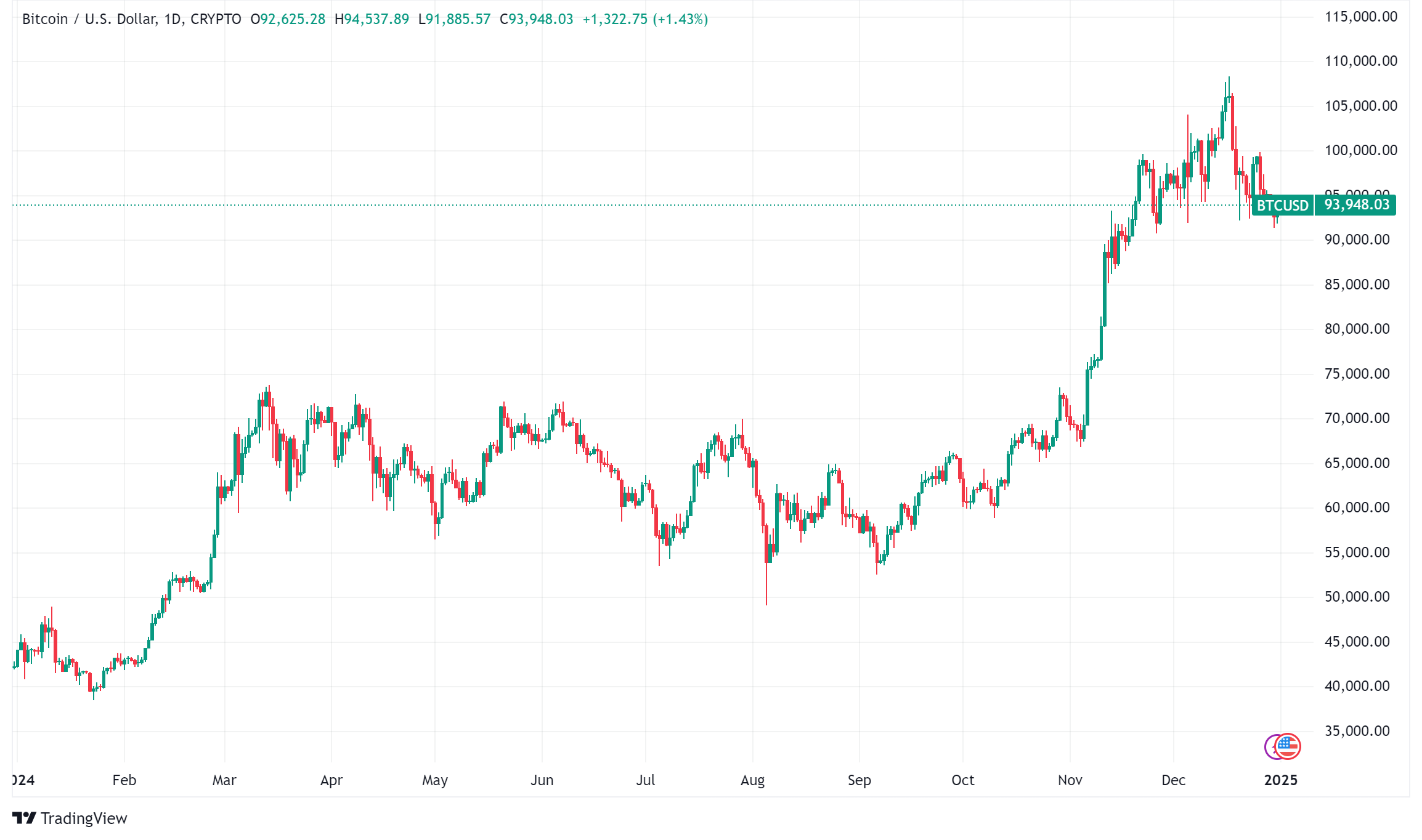
Bitcoin, the trailblazer of the cryptocurrency era, reached extraordinary heights in 2024. December marked an all-time high of over $108,000, representing a 120% surge for the year. This growth was driven by several factors, including the U.S. approval of multiple spot Bitcoin ETFs, which brought in over $25.79 billion in institutional inflows.
On-chain activity also reached new peaks, with daily transactions hitting 927,010. The network’s hashrate surged to an impressive 766 EH/s, enhancing its security and resilience. Bitcoin’s influence extended beyond trading; it achieved $3.29 billion in total value locked within DeFi and climbed to third place among blockchains for NFT sales, with $4.63 billion in cumulative transactions.
As 2025 approaches, expectations are high, particularly with the upcoming halving event. Analysts predict Bitcoin’s price could range anywhere between $25,000 and $120,000, reflecting the market’s mixed but generally optimistic outlook. Bitcoin’s growing adoption, strong institutional interest, and established role as a hedge against inflation underscore its staying power. With unmatched liquidity, robust network effects, and a central role in driving innovation across DeFi and NFTs, Bitcoin continues to solidify its position as a cornerstone of the digital economy.
2. Ethereum (ETH)
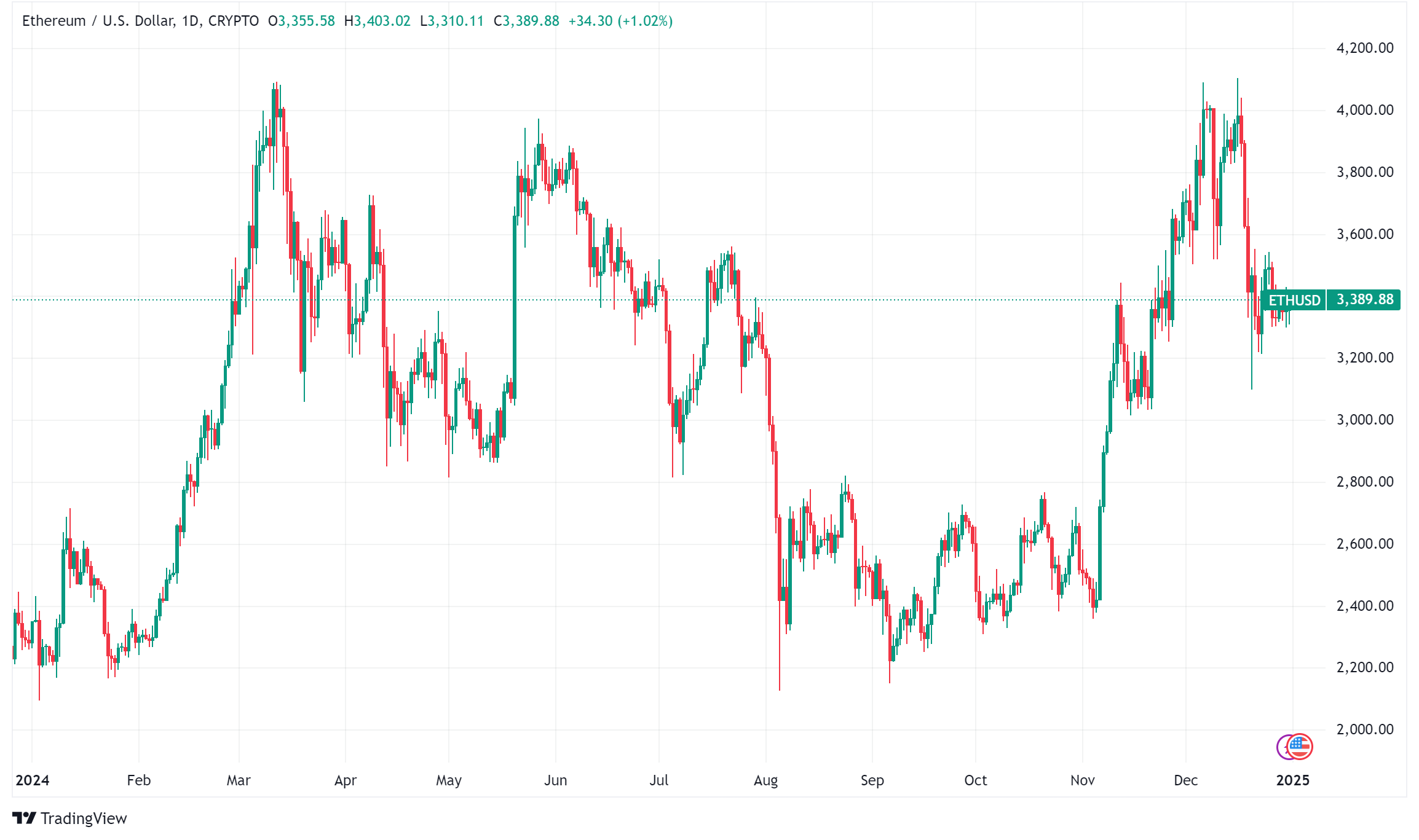
Ethereum has firmly established itself as the backbone of the decentralized application (dApp) ecosystem since its debut in 2015. By pioneering smart contracts, it opened the door for sophisticated applications across industries like finance, governance, and digital art.
In 2024, Ethereum’s price climbed over 46%, reaching $3,630. The network’s total value locked (TVL) in DeFi and staking soared to $70 billion, with Lido DAO alone accounting for $35 billion. This growth highlighted the increasing demand for staking derivatives. Meanwhile, the launch of the first Ethereum spot ETF in the U.S. fueled institutional interest, further solidifying Ethereum’s position as a cornerstone of the crypto market.
Looking ahead, 2025 could mark a new chapter for Ethereum, bolstered by major network upgrades and favorable regulatory shifts under the Trump administration. The highly anticipated Pectra upgrade promises to enhance staking efficiency and scalability by increasing validator balance limits.
Alongside this, Ethereum Improvement Proposals (EIPs) and advancements in Layer-2 solutions aim to improve interoperability and user experience. With strong momentum in key sectors like stablecoins, tokenization, and AI integration, Ethereum is well-positioned to lead the next wave of blockchain innovation. Experts suggest Ether could surpass its previous all-time high, potentially hitting $7,000, driven by recent ETF inflows of $1.5 billion.
Supportive policies from the new SEC leadership are expected to accelerate Ethereum’s growth further. Areas like DeFi, restaking, and decentralized applications stand out as critical for expansion, with innovations like EigenLayer offering enhanced security. Already competing with centralized platforms like Binance, Ethereum’s ecosystem is primed for significant growth as regulatory clarity encourages institutional and entrepreneurial participation. With unmatched adoption and continuous technological progress, Ethereum is poised to redefine the blockchain landscape, reaffirming its role as the “comeback kid” of 2025.
3. Solana (SOL)
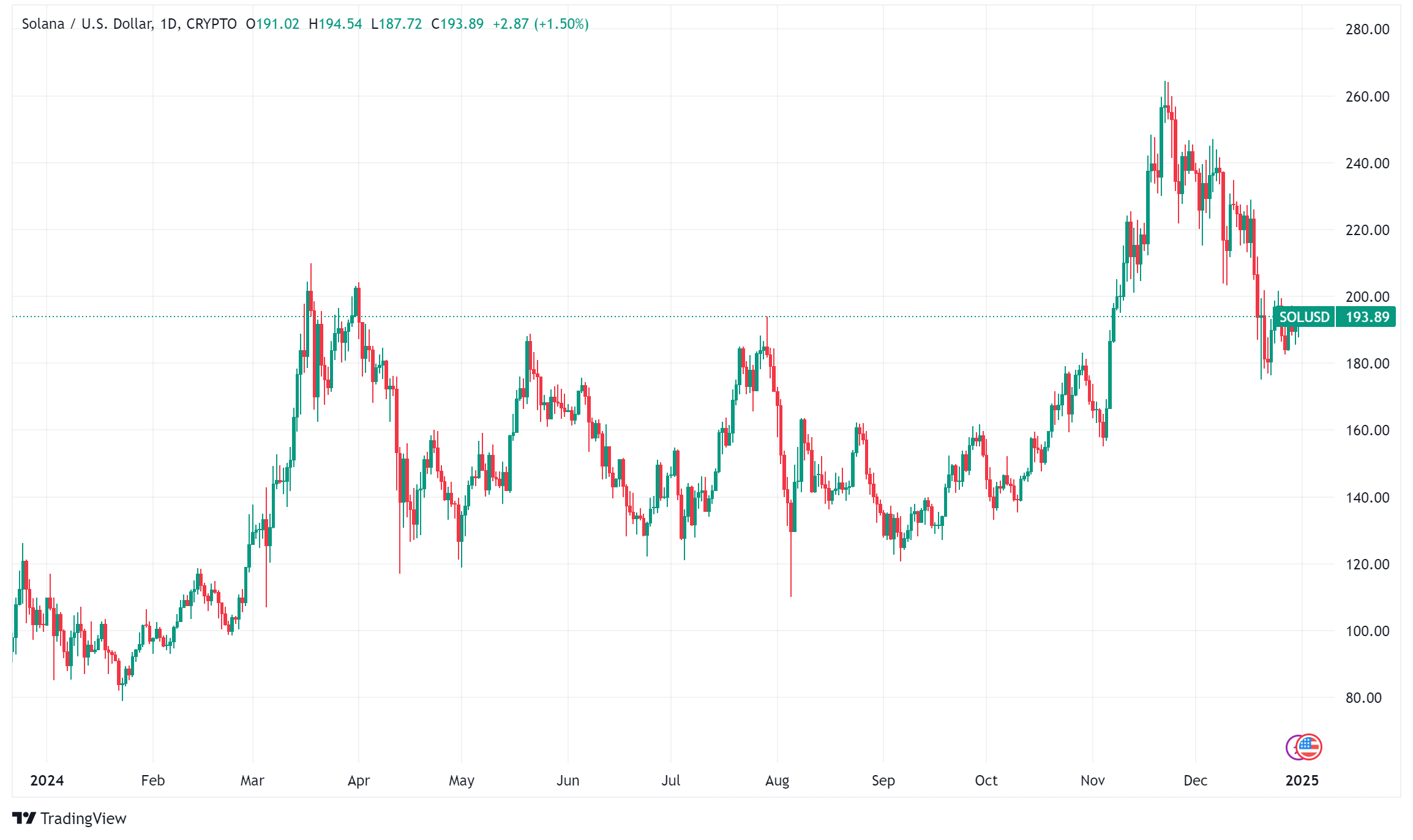
Solana has firmly established itself as a leading blockchain for speed and scalability, using its innovative proof-of-history (PoH) consensus to process over 65,000 transactions per second. In 2024, Solana’s price climbed 86%, reaching a peak of $244. This growth was fueled by ecosystem expansion, the integration of Circle’s USDC, and the rising popularity of tap-to-earn games. These developments bolstered Solana’s reputation as a versatile platform for DeFi, gaming, and NFTs. However, concerns around memecoin activity on platforms like pump.fun and the SEC’s classification of SOL as a security presented challenges to its momentum.
Looking ahead, 2025 is shaping up to be a pivotal year for Solana, with several key innovations on the horizon. The Firedancer client, developed by Jump Crypto, is expected to significantly enhance decentralization and network efficiency, drawing comparisons to Ethereum’s transformative Merge.
Meanwhile, the ongoing restaking race between platforms like Jito and Solayer could redefine validator infrastructure, offering new possibilities for scalability. At the same time, experiments with novel DAO governance models and initiatives like hackathons and incubators are setting the stage for a vibrant developer ecosystem and increased institutional interest.
Solana’s core narrative emphasizes simplicity, speed, and affordability, attracting developers who want to build without the complexity of creating new smart contracts. While recent growth has been driven by memecoins and ETF applications, the blockchain’s ability to adapt its story will be essential for sustaining its momentum. With upcoming events like the Solana Breakpoint conference and a strong pipeline of innovations, Solana is well-positioned to expand its influence and remain a prominent player in the expanding crypto market.
4. The Open Network (TON)
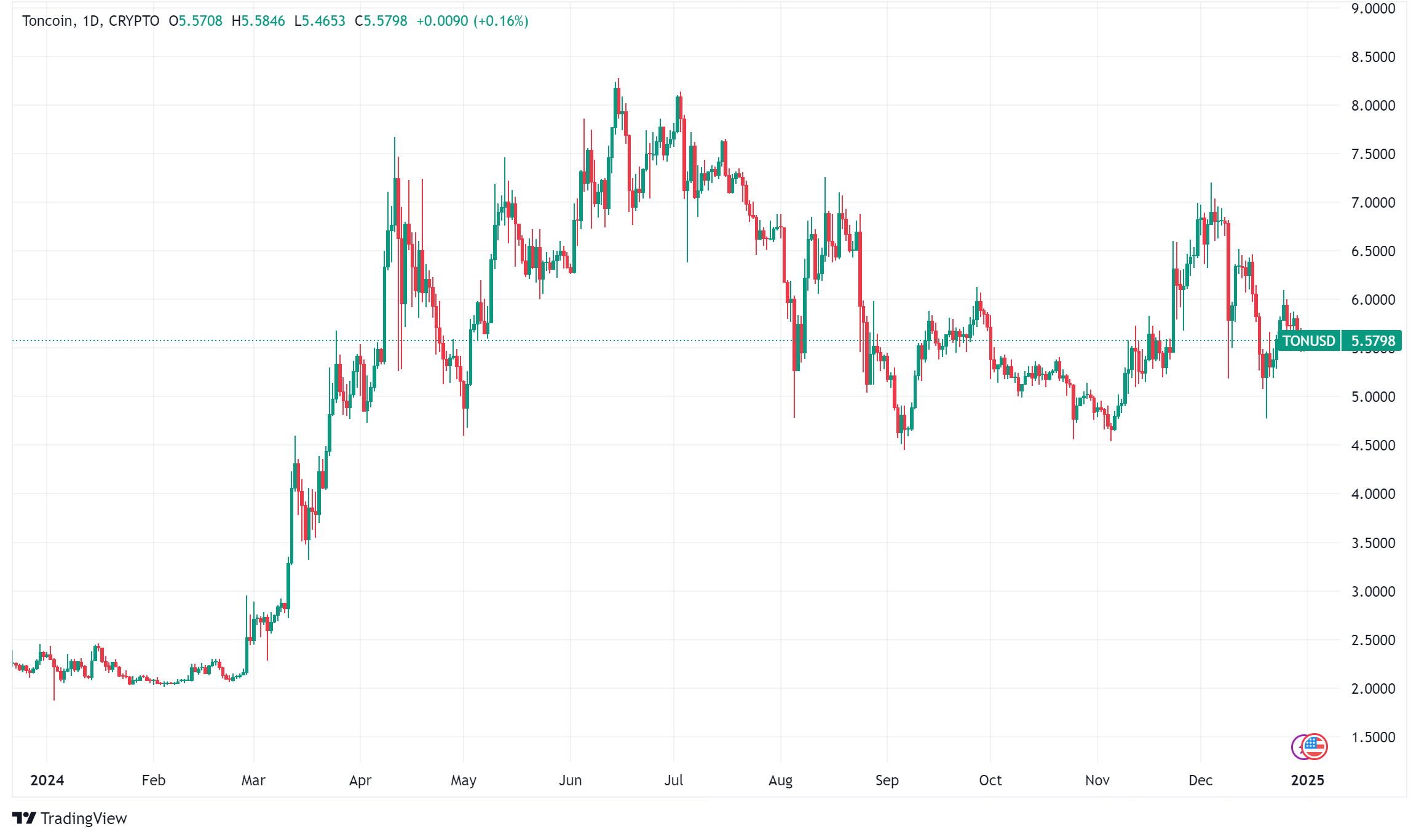
Originally developed by Telegram, The Open Network (TON) has quickly risen as a prominent Layer-1 blockchain, leveraging its deep integration with Telegram’s ecosystem, which boasts over 950 million active users. In 2024, TON’s price soared nearly 143%, ranking it among the year’s best-performing blockchains.
Its strength lies in user-friendly applications like “tap-to-earn” games, decentralized tools, and mini-apps, making it easy for Web2 users to transition into Web3. Platforms such as BitGet, Curve Finance, and Binance have joined the TON ecosystem, further signaling growing institutional interest. Telegram’s hands-on approach, allowing innovation directly within its app, has also positioned TON as a major contender in the superapp race against giants like Google and Meta.
Despite its rapid ascent, TON faces significant challenges, particularly around user retention and regulatory scrutiny. Mini-games like Hamster Kombat initially attracted massive engagement, peaking at 300 million users, but later saw steep declines in both active users and token value. This highlights a critical risk: maintaining user interest beyond initial rewards. Regulatory concerns add another layer of complexity, as increased scrutiny of social media platforms and blockchain systems could impact TON’s growth and public perception. However, the incoming U.S. administration’s pro-crypto stance offers a glimmer of hope, potentially easing some of these challenges with more favorable policies.
Looking forward, TON’s roadmap outlines ambitious plans to expand its ecosystem. With its unparalleled access to Telegram’s vast user base, TON has a unique opportunity to onboard millions of new users into the crypto economy. However, its future success will hinge on retaining an engaged community, navigating regulatory hurdles, and continuing to attract developers and institutional partnerships. If it can address these challenges, TON is well-positioned to remain a leader in the social blockchain space.
5. Sui (SUI)
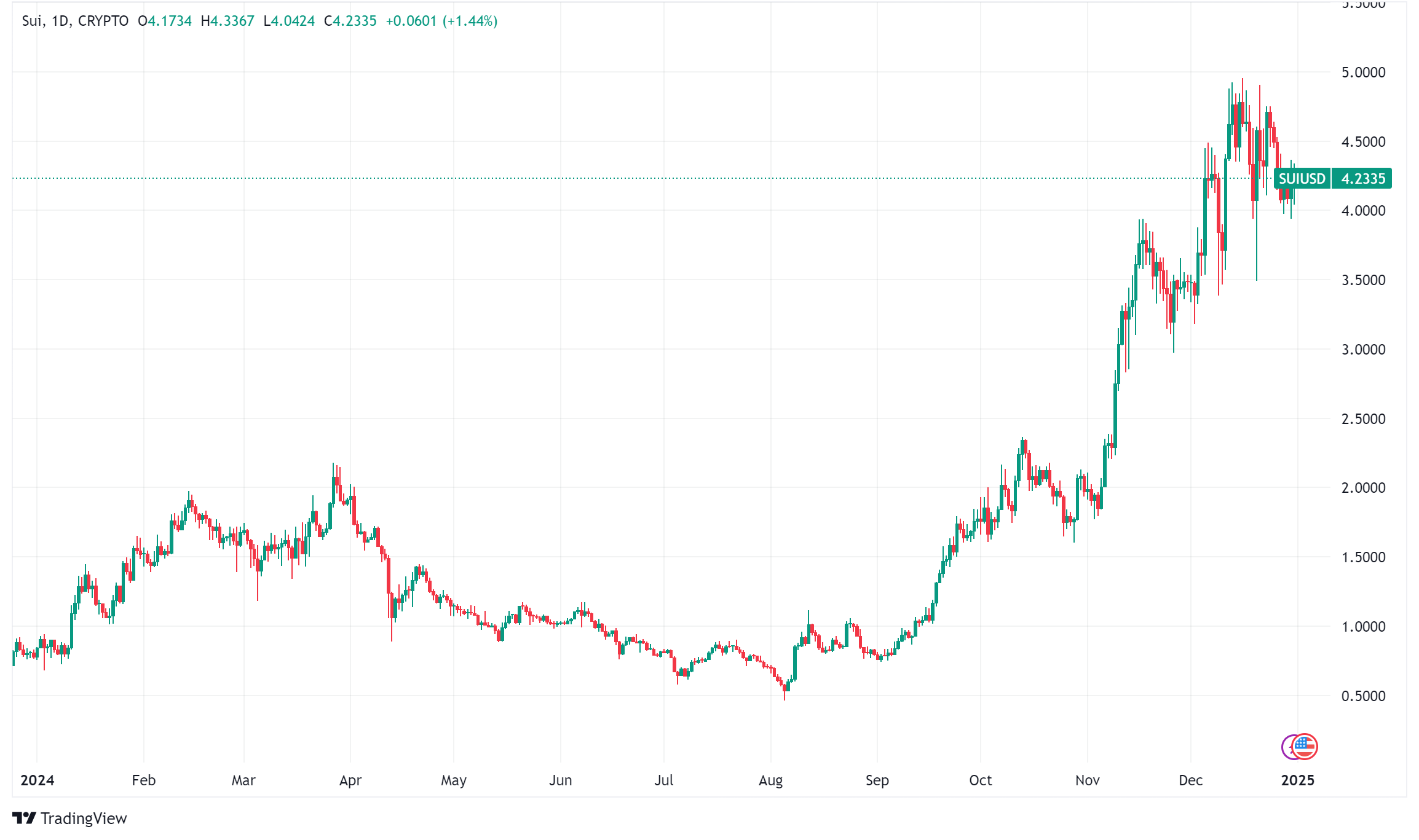
Sui has quickly risen as a prominent Layer-1 blockchain since its 2023 launch, thanks to its cutting-edge architecture and focus on scalability. By leveraging its object-centric data model and the Move programming language, Sui delivers impressive performance, processing over 297,000 transactions per second (TPS) with low latency.
In 2024, Sui’s market capitalization skyrocketed by over 417%, reaching $12.3 billion. Notable milestones included the Mysticeti upgrade, which slashed consensus latency by 80%, and the launch of the Grayscale Sui Trust, attracting significant institutional attention. These developments underscore Sui’s appeal to both developers and institutional investors.
The growth of Sui’s DeFi ecosystem in 2024 was equally remarkable, with total value locked (TVL) exceeding $1.75 billion by year-end. Stablecoin offerings such as USDC and AUSD, alongside innovations like DeepBook V3 and the Sui Bridge, have strengthened liquidity and cross-chain capabilities.
DeepBook V3 alone facilitated nearly $1 billion in trading volume, while partnerships with VanEck and Franklin Templeton extended Sui’s presence in traditional finance. Wallet integrations with providers like Phantom and Backpack further enhanced accessibility, enabling millions of users to engage with Sui’s DeFi applications seamlessly.
Outside of DeFi, Sui has made significant strides in the gaming sector. The launch of the SuiPlay0X1 handheld device and web3 games like SWAYE and DARKTIMES showcases the network’s ability to bridge traditional gaming and blockchain technology. These initiatives have not only attracted gamers but also inspired developers to build within Sui’s ecosystem. As the blockchain continues to expand its partnerships and innovative offerings, Sui is well-positioned to remain at the forefront of blockchain technology as it heads into 2025.
What to Expect from Layer-1 Blockchains in 2025
The future of Layer-1 blockchains looks bright as several trends are set to shape the industry:
- Real-World Asset Tokenization: With Ethereum and Sui leading this effort, the tokenization of RWAs is projected to pick speed. Blockchain is under growing investigation by institutions for commodities, bonds, and real estate among other assets.
- Gaming and Social Media Integration: Platforms like TON and Solana will keep ruling in applications of social blockchain and gaming. Social dApps and tap-to- earn games are projected to draw millions of fresh people into the crypto scene.
- Scaling Solutions: Together, Layer-1 blockchains and Layer-2 solutions will increase scalability. Solana’s high throughput and Ethereum’s roll-ups will redefine performance criteria.
- Regulatory Progress: Layer-1 networks with strong compliance systems will get an advantage as governments set more defined rules. Ethereum’s connection with institutional-grade products, such ETFs, will probably encourage analogous developments on other networks.
Conclusion
Layer-1 blockchain resurgence in 2024 emphasizes their vital importance in forming the decentralized economy. Rising remarkably in many aspects of blockchain utility, Bitcoin, Ethereum, Solana, TON, and Sui have shown great development. While Bitcoin and Ethereum continue to rule, Solana, TON, and Sui draw attention to the Layer-1 ecosystem’s variety and innovation.
These networks are ready to aggressively address scalability, acceptance, and regulatory obstacles as 2025 plays out. Key to maintaining their momentum, their capacity for adaptation and evolution will make them indispensable actors in the always growing field of blockchain technologies.
